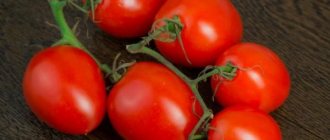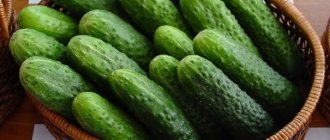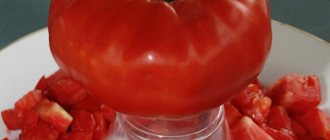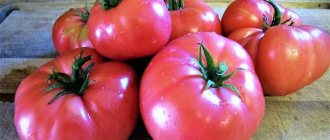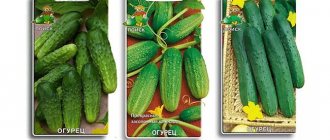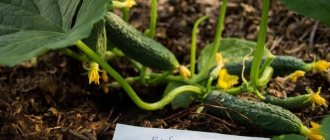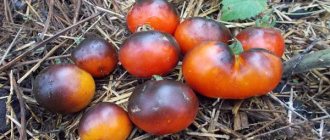History of selection
The Red Fig tomato was bred in 2012, the originator is the seed company Gavrish (Russia). The variety is suitable for growing in greenhouses and open beds.
The variety was specially bred for cultivation throughout the Russian Federation. In the southern regions of the country, the Fig tomato can be planted in open ground. In the Middle Zone and the North, this variety is recommended to be grown only in a greenhouse.
There are three varieties of this variety of tomatoes: red, yellow and pink fig tomato. They differ only in the color of the fruit, their size and slightly in taste. The yellow variety only appeared last year and has not yet become widespread.
Advantages and disadvantages
The description of this variety includes several advantages:
- large-fruited and increased sweetness of the fruits;
- good marketability;
- non-standard appearance;
- high degree of seed germination - up to 95%;
- practically undamaged by fungal and viral diseases;
- the harvest is suitable for further ripening at home.
There are two disadvantages: the plant is poorly resistant to cold, so growing it in an open garden is possible only in the southern regions of the country. In the North and Middle Zone, tomatoes are grown in greenhouse conditions. Another disadvantage is that the bush needs staking, which makes caring for the bushes a little more difficult.
Description of the tomato Pink Fig
Mid-season, tall variety. The height of the plant reaches 3 m, so tying is necessary. The bushes are spreading, the stem is strong and massive. On young shoots and leaves, an increased number of glandular hairs is observed, which is why they acquire a greenish-gray tint. The leaf has carved edges, the top has a more saturated color, the bottom is paler.
Each cluster bears from 3 to 5 fruits; on the lower branches the fruits are larger. The bush blooms and bears fruit throughout the season. The yield of 1 bush is 6-7 kg. The weight of the berries is from 300 to 700 g, some samples can reach 1 kg. The tomatoes are large, fleshy, with a lot of ribs. These tomatoes have a large number of seed chambers. The fruits are flat-rounded and have a slightly flattened shape. The skin is thin, but does not crack. During transportation they do not lose their commercial qualities.
Tomatoes can be picked before they are ripe, and they will ripen indoors without losing their taste. The Pink Fig tomato is used for collecting juice for the winter and for preparing salads.
Unsurpassed taste
The name of the variety fully justifies itself. Figs seem to grow on a familiar plant of the nightshade family: these tomatoes resemble the fruits of a fig tree in taste.
The illusion of a fruit delicacy arises: pure sweetness and rich aroma. There is no trace of “tomato” sourness. Increased sugar content is observed even in those fruits that were picked green and ripened outside the bush.
Recognizable form
The shape of the fruit is memorable, but can be twofold. On some bushes, the tomatoes are pear-shaped, slightly reminiscent of the famous Truffle variety (Light Bulbs). By the way, figs have a similar shape. And on some bushes fruits grow round, strongly flattened from below and from the top, like in the picture from a packet of seeds from “Gavrish”. Both types are united by a clearly expressed uniform ribbing, almost an “accordion”, as if cutting along most of the surface.
The cut shows an atypical, hypertrophied multi-chambered fruit. Sometimes (especially if there is a lack of nutrition to the bush) small voids are observed inside, as for stuffing, but this happens rarely. In general, tomatoes do not look ugly - on the contrary, the tomatoes are quite smooth and very beautiful.
Appetizing coloring
In our minds, pink tomato fruits are strongly associated with high taste qualities. This is the favorite “tomato” color of many vegetable growers. Even the classic red tomato seems less attractive.
For the Pink Fig tomato, it is more appropriate to talk not so much about pink, but about the rich light raspberry shade of the peel and pulp. The top is sometimes green, disappearing in full biological ripeness.
Decent size
Another important characteristic is the fullness of the fruit. The average weight ranges from 300 to 400 grams. With a lower limit of 200 grams, the maximum weight is four times greater. Tomatoes weighing 400–600 grams are not uncommon. Each brush carries 3-5 pieces of these “beauties”. One bush produces up to seven kilograms of “vegetable figs” per season.
The main harvest is spent on colorful fresh salads. Smaller fruits are suitable for pickling. It is also good to dry pink figs.
The tomato will taste like raisins. The juice (without adding salt) will also seem fruity, which is very useful for baby and dietary nutrition, even with increased stomach acidity.
Application area
Thanks to their excellent taste, Pink Fig tomatoes can be eaten fresh, and you can also prepare summer salads based on them in combination with herbs. The fruits can also be subjected to heat treatment, as this does not affect the taste.
Tomatoes and pink figs are recommended for cooking:
- lecho;
- juice;
- pastes;
- sauces;
- canning in pieces.
Important! Pink figs are characterized by long-term yield of tomatoes, which is due to the continuous growth of shoots.
Characteristics of the variety
A characteristic feature of the fig variety tomato is its high yield and rapid ripening period. The height of the bushes can reach three meters, and the foliage cover of the stems is not very lush. It is worth noting that this variety requires very careful and constant care. When breeding it, staking the stems is mandatory, since large fruits will bend them and bend them to the ground.
Most vegetable growers prefer fig tomatoes because of their high yield. The yield of one bush per season reaches 6 kilograms of fruits, which have a spherical shape, slightly flattened on top, and on the sides of the vegetable there are peculiar ribs, thanks to which tomatoes resemble exotic fruits. The fruits are quite large and weigh on average about 500 grams.
The fruits of this variety are characterized by an original and unique taste. The pulp is very soft and juicy with high sweetness and a slight fruity undertone. In terms of its taste, the “fig” tomato is unlike other existing varieties, so its fastidiousness in care is fully compensated.
Fig tomatoes are divided into three main varieties, the taste of which is almost identical, the main difference being the color. Tomatoes come in red, pink and yellow. Thanks to their different colors and unique taste, tomatoes of this variety have found active use in cooking. They are great for preparing various salads and for decorating many other dishes.
Characteristics table
The description of the Pink Fig will be interesting for both experienced and novice gardeners.
Advantages and disadvantages of the variety
Large fruits with a pleasant taste are not the only advantage of the Fig tomato. Advantages of the variety:
- high productivity;
- resistance to many tomato diseases;
- high percentage of germinating seeds.
The main disadvantages of the Fig variety are related to the peculiarities of caring for tall bushes. Indeterminate tomatoes need to be provided with reliable support; the bushes should be regularly tied up (especially the clusters with fruits). Powerful plants require increased fertilization of the beds.
Varieties of Fig tomatoes
Summer residents have a choice of 3 types of Fig tomatoes. Distinctive features are a slight difference in the size of the fruit, the shade of the skin and pulp.
Pink
If growth is not limited, the plants reach a height of 3 m. The shape of the fruit is unusual, vaguely reminiscent of a real fig. The tomatoes are ribbed, the skin is pink.
One bunch grows up to 5 tomatoes. The weight varies, depending on care, the average is 250-450 g. But summer residents claim that in some cases the size reaches over 1 kg. Thus, the yield is 5-7 kg per bush.
The taste characteristics are excellent, there is no acid, a soft fruity taste predominates.
Red
Another type of tomato is Fig. The plants are tall, the maximum height is 2 m. The pronounced ribbing of the fruit makes it look like a fig. Red tomatoes reach 350-400 g. The fruit tastes fleshy, sugary, without sourness. Subject to all planting rules and regulations and proper care, 1 m2 yields 12 kg of vegetables.
Yellow
Recently bred, it belongs to the determinate varieties. The maximum height is 100 cm. Yellow tomatoes grow up to 250 g. The ribbing is weaker than that of other representatives of Figs. The pulp is sugary, tender, there is no acid in the taste. Harvest volume per 1 m2 is 7-9 kg.
Planting tomatoes Pink figs
The timing of sowing seeds depends on the region and method of growing tomatoes. When planting in a greenhouse, seeds are sown two weeks earlier.
In most cases, seeds are sown in March. In the northern regions of the country - in the first half of April.
Preparation of planting material
Before planting seeds, they must be prepared. Planting material is disinfected and soaked in a growth stimulator.
Seed preparation methods:
- Several types of compounds are used to disinfect seeds. For example, solutions of potassium permanganate (1 part potassium permanganate and 100 parts water), soda (0.5 tsp soda and 100 ml water), aloe (1 part aloe juice and 1 part water). The seeds are soaked in potassium permanganate for half an hour, and in aloe and soda for a day.
- After disinfection, the seeds are washed with running water and dried with a paper towel.
- To stimulate growth, pieces of cloth in which the seeds are wrapped are moistened with the solution. The fabric with the seeds is placed in a plate, covered with film and placed in a warm place for a day. Epin, Kornevin, Silk, Zircon, and Sodium Humate are used as growth stimulants.
Advice! Make sure the quality of the planting material. Check the expiration date of the seeds and soak them for half an hour in salted water. Floating seeds are considered unusable.
Selection of containers and soil
For sowing seeds, use special or homemade containers. They should be wide, but not deep.
Small 300 ml pots are suitable for picking.
The basis of the soil mixture for tomatoes is chernozem and humus. To lighten the composition, sand, sawdust or crushed coconut fiber are added to it. To improve the soil, it is mixed with ash and Fitosporin.
Purchased mixtures are also used. Select soil “for tomatoes and peppers.”
Advice! Experienced gardeners recommend using soil for seedlings taken from a greenhouse. It is believed that this will make it easier for tomatoes to take root after transplanting to a permanent location.
To disinfect the soil, it is calcined in the oven, watered with boiling water or a solution of potassium permanganate. The containers are soaked for half an hour in a strong solution of potassium permanganate or in boiling water.
Sowing technology
Before sowing, the planting containers are treated with copper sulfate and dried. The soil placed in the container is leveled, slightly compacted and moistened. Sow in rows 0.5 cm deep with a step between them of 5 cm. The seeds are laid out in rows at a distance of 2–3 cm and sprinkled with dry sand on top. The surface of the box is covered with polyethylene or glass. This will maintain optimal humidity and speed up the emergence of seedlings.
During the germination phase, the seeds do not need lighting, so the boxes are placed in dark rooms where a stable temperature is maintained. The soil is moistened with a spray bottle as needed. Every day the cover is removed for a while to ventilate the soil and assess its condition. After germination, the cover is removed completely and the seedlings are moved to a well-lit place.
Growing rules
By observing the requirements for planting and growing, the summer resident will receive a rich harvest of tasty fruits.
Sowing seeds
The vegetable grower obtains the planting material independently, since Figs are not hybrids. Some people prefer to purchase seeds in the store. Before planting plants, it is necessary to prepare planting material. To disinfect, they are lowered for 30 minutes. into a weak solution of potassium permanganate. Then the seeds are removed and dried.
Before planting, soak for 1-1.5 hours in a growth stimulator. Then they are dried and sown in prepared containers. Soil for seedlings can be purchased at the store or prepared independently.
Caring for fig tomatoes
When growing in a greenhouse, you will need to pay more attention to feeding. Without it, plants will quickly draw nutrients from the soil and stop growing. During the flowering period, the plants are shaken to ensure pollination. They also reduce air humidity to 50% and increase daylight hours to 13–18 hours. Good lighting promotes the formation of powerful plants with short internodes, which simplifies care.
Watering
To maintain soil moisture, it is better to organize drip irrigation in the form of a strip system distributed along the entire perimeter of the plantings. The application of liquid is combined with fertilizing. For example, they fertilize in the morning and water in the evening. Each plant should have 3–4 liters of water.
Loosening and weeding
The soil needs to be loosened after each watering. This prevents moisture stagnation and enriches the root system with oxygen. In parallel with loosening, weeding is carried out. Loosening is carried out with a sabot. In the row-spacings the aeration depth is 10 cm, directly in the hole – 5 cm.
Stepsoning
Pinching is a necessary procedure when growing tomatoes of this variety. It involves the removal of not only excess stepsons, but also flower brushes. The first stepsons are formed in the axil between 5–6 leaves, in the period after picking the plants into the greenhouse
As soon as they reach a length of 5 cm, they are removed by carefully pinching them off with your hands. In the future, stepsoning is carried out every 10–14 days
It is more convenient to form a bush into 1 stem.
This formation involves the following activities:
- removal of all side shoots throughout the plant's life cycle;
- removal of the first 2 flowering clusters - manipulation allows you to increase the number of inflorescences and speed up the fruiting process;
- removal of clusters with fruits - carried out at the beginning of the fruiting phase;
- removing all leaves located in the lower part of the bush, up to the first flowering cluster;
- pinching the growing point a month before harvesting the last fruits, leaving 2-3 leaves free from flowers at the top.
Feeding
About 6 feedings are carried out per season:
- 3 root using organic matter;
- 3 foliar using mineral fertilizers containing potassium and phosphorus.
After 10 days, spray with monophosphate. During the fruit filling phase, 10–14 days after spraying, you can again use yeast fertilizer, only without compost. Dilute 1 tbsp in warm water. l. sugar and a package of dry yeast (25 g), leave for 2 hours. The resulting mixture is applied to the soil at the rate of 2 liters per plant.
In addition to fertilizing with potassium and phosphorus, you can also use liquid manure or chicken droppings.
Fertilizing should be done once every 3-4 weeks, alternating mineral complexes with organic matter.
To improve the taste and speed of ripening, tomatoes need to be fertilized with the following solution:
- 2 tbsp. spoons of superphosphate;
- 1 tbsp. a spoonful of liquid sodium humate;
- 10 liters of water.
You will need to pour 1 liter of prepared liquid under each bush.
To increase the yield, tomato bushes can be watered with a stimulating agent, which is simply prepared from the following ingredients:
- 1 cup sifted wood ash;
- 10 g boric acid;
- 10 liters of water.
Shaping and garter
- On one square meter of the greenhouse there are 3 - 4 seedlings.
- A strong, well-thought-out garter eliminates unpleasant “surprises.” Weak supports lead to bushes breaking under the weight of the harvest and powerful vegetative mass.
- Planted young plants need to be tied up as soon as possible - they grow very quickly.
- During the growing season, not only the stems are fixed, but also large brushes.
- Fruit size and yield directly depend on timely pinching. In the Pink Fig, the side shoots do not grow very actively, but their regular removal is necessary. The variety is grown in one stem (under particularly favorable conditions - a maximum of two stems).
- When the first clusters are formed, the lower leaf tier is removed.
- About a month before the expected end of the growing season, pinch off the top of the bush.
Subtleties of care
At the stage of growth and development, the Red Fig variety needs careful care, which will ensure good yield and immunity against diseases.
- For irrigation, use settled water at room temperature. Up to 2 liters of water are poured under each bush. Moistening is carried out as the top layer of soil dries. During the fruiting period, plants especially need moisture, because if there is a lack of it, the tomatoes will grow small and not so juicy. During the fruiting phase, the bushes are watered every 5 days. After the procedure, the soil is loosened to avoid the formation of a crust on the surface. Weeds are also removed and rows are weeded.
- Fertilizers. Tomatoes need to be fed at least 3 times throughout the entire season. Superphosphate and potassium nitrate are added per m² - 1 tbsp each. l. on a bucket of water. 0.5 liters of working solution is poured under each plant. This feeding at the root is carried out two weeks before flowering and two weeks after it.
- To increase productivity, a solution of 10 g of boric acid, 2 liters of wood ash and 10 liters of water is added to the fruit set phase. 1 liter of nutrient liquid is poured under each bush.
- During the period of active fruit ripening, the bushes are fertilized with liquid sodium humate (1 tbsp.), superphosphate (2 tbsp.) per bucket of water. This composition improves the taste of tomatoes. The following foliar fertilizers are used: Kristalon, Master, Kemira or Sudarushka. Irrigation is carried out at the beginning of flowering and 10 days after the bushes have faded.
- Gartering is a mandatory procedure. After transplanting into open ground or a greenhouse, each bush is tied into a peg and continues to be fixed as the shoots grow. To prevent the stems from breaking off under the weight of the fruit, each cluster must be tied to a support. To obtain large fruits, the bushes are formed into 2 stems, removing excess shoots and shoots.
To prevent infection with diseases, tomato should be treated with Fitosporin.
Spraying the bushes and soil between the rows is carried out 3 times:
- two weeks after transplanting the seedlings;
- before flowering;
- two weeks after it.
Spraying with a decoction of celandine, wormwood, infusion of onions, garlic and marigolds will help prevent the appearance of pests.
Twice treatment is required: 2 weeks after transplanting the seedlings into the ground and after the bushes flower.
At an advanced stage of the infection, bushes that have begun to bear fruit are removed from the site.
Harvest and storage
The variety has a long fruiting period, so the last fruits are harvested in September, and the first at the end of June. Tomato harvesting begins when they are not yet fully ripe. The fruits are picked along with the cuttings. The most mature specimens are harvested first.
After harvesting, the tomatoes are sorted by degree of ripeness and placed in containers lined with straw in a single layer. Store in well-lit rooms at a temperature of +20 °C. Green tomatoes reach maturity in 10–15 days. In total, tomatoes are stored for 2-3 months.
Important! In unheated greenhouses, you need to have time to harvest the entire crop before the night temperature drops below +8 ° C. Fruits collected at this temperature cannot be stored - they quickly rot.
The Red Fig tomato variety is more suitable for growing indoors. It has an unusual appearance and high taste. It is demanding in care, but the costs of labor and money are compensated by the quality and quantity of fruits.
Diseases and pests
Greenhouse tomatoes are more often affected by diseases. They need timely prevention of fungal diseases. For this purpose, the bushes are regularly sprayed with the fungicidal preparation “Fitosporin” or a light pink solution of potassium permanganate.
On a note! To prevent the creation of favorable conditions for the development of fungal diseases in the greenhouse, it should be equipped with a ventilation system.
Insects that are attracted to the juicy greens of tomatoes are destroyed with the help of insecticides: Aktara or Confidor Maxi. Due to toxicity, they are not recommended for use during the formation of ovaries and ripening of fruits. During this period, tomatoes are treated with plant decoctions that repel whiteflies, aphids and spider mites. To prepare a natural remedy, use herbs and flowers of chamomile, celandine, marigold or yarrow. An infusion of onion peels effectively gets rid of harmful insects.
You can overcome a nematode that damages the root system with the help of Tiazone, Vidat or Carbation. They are used to disinfect the soil in which the pest was identified. The drug is applied to a depth of 15 cm 3 weeks before planting the seedlings, following the instructions.
Preventive measures
Starting in June, it is recommended to carry out preventive spraying of bushes against fungal diseases. For this you can use the following drugs:
- "Fitosporin";
- "Ridomil Gold";
- "Hom."
Treatment should be done every 10-14 days, alternating products to avoid pathogens becoming addictive.
When growing crops in a greenhouse, whitefly damage is possible. This is facilitated by high humidity and elevated temperature. To destroy the pest, it is necessary to spray and water the bushes with Aktara. If it is impossible to use an insecticide during the period of fruit ripening, a decoction of celandine and onion peel should be used.
Features of care
First of all, you should pay attention to regular feeding. For the first time, Fig tomatoes are fed when the first leaves appear on the seedlings. It is important to add only a complex of vitamins and minerals. Root and foliar feeding should also be carried out. To do this, it is recommended to use only minerals with a high concentration of phosphorus or potassium compounds.
As soon as the seedlings are transplanted into open ground or a greenhouse, each bush is tied to a trellis. When new fruits are formed, each bunch is attached to the trellis.
To achieve a rich harvest, the bush is regularly formed into 1-2 stems, removing all side shoots.
Among other things, the soil is regularly loosened and all weeds or wires are removed. The beds are weeded so that a crust does not form around the bush and the root system does not rot.


